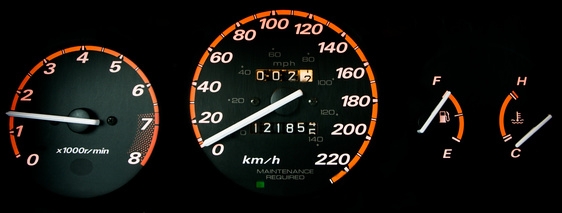
An instrument panel, also referred to as a dashboard, is the surface below the windshield of a vehicle that provides the driver with a number of readouts regarding the operation of the vehicle. Instrument panels are usually padded to ensure safety in the case of a crash. Common features of an instrument panel include the tachometer, speedometer, odometer and fuel gauge.
The tachometer's readout describes the operating speed of an engine. Specifically, it represents the number of revolutions that the engine's crankshaft makes per minute. These units are shortened with the designation "rpm." On most tachometers, frequencies that exceed the vehicle's maximum safe operating level are marked in red. However, modern vehicles usually have a built-in limiter that prevents the engine from exceeding this level anyway.
Reading a tachometer is a subtle way to evaluate the performance of a car engine. If a car used to run at 2,000 rpm when traveling at 40 mph, but later it needs to run at 3,000 rpm to go the same speed, the driver can infer that something is wrong. In addition, when the engine misfires, the driver will see the tachometer's needle swinging wildly.

A speedometer measures the instantaneous speed of a land vehicle. On a boat, a similar device is called a pit log, while on an aircraft it is called an airspeed indicator. A car or truck's speedometer consists of a sensor connected to the drivetrain of the vehicle that transmits information about the rotation of the drivetrain to a needle or other indicator on the instrument panel. Until the 1980s, the only type of speedometer used was an eddy current speedometer, which used magnetic fields to transmit speed information. This type is still in use today, but electronic speedometers that communicate via electric pulses have also become common.

The odometer indicates the distance traveled by a vehicle during its entire existence. Many vehicles also include a trip odometer, which can be reset to provide a reading of a shorter distance. The odometer is an important aspect in determining the market value of an automobile, as it can indicate how much wear the vehicle has undergone. For this reason, it is illegal in many jurisdictions to tamper with an odometer. Vehicles with digital odometers store information in the engine's computer, and this data is more difficult to corrupt.
A fuel gauge indicates the amount of remaining fuel in a vehicle's tank. A fuel gauge usually consists of a float buoyed in the fuel that sends electronic readings to the indicator on the instrument panel. When the fuel reaches a certain minimal level, a warning light will illuminate in the instrument panel of most vehicles.
